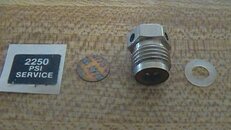Bob DBF
Contributor
Yeah, maybe, if you don't panic. For a burst disk (is that an O-ring?) it said you have 72 secs from a full 80 cf -- that's not a lot of time to get to the surface from 60 feet. And then no air to inflate your BCD when you get there. You better have a pony or a buddy!
So we're all practicing oral inflation, right?
- Bill
Burst disc is the over-pressure relief, set below hydro pressure, so the tank will not rupture if subjected to overheating or a crazed fill monkey.
It is a copper disc under a small nut, with holes in it, on the tank valve. (Disc set below)

I haven't run across one that burst underwater. Yet.
For those of us that were trained at 60' / min to the surface with no safety stop, it is plenty of time, even if solo. Gets to be more of an issue as you go deeper.
With an empty tank I float on the surface so I have plenty of time to inflate, but yes. One of the many reasons for proper weighting.
Most of these issues can be avoided by inspecting and maintaining your gear regularly.
Bob
------------------------------------------
"No matter what happens, somebody will find a way to take it too seriously" -Dave Barry




